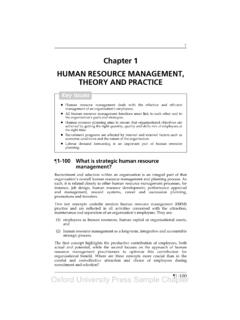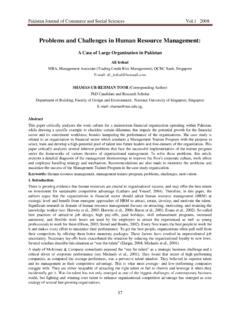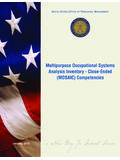Transcription of Human Resources Planning - ed
1 American Journal of business Education October 2009 Volume 2, Number 7 1 Strategic Human resource Planning In Academia Gregory Ulferts, University of Detroit Mercy, USA Patrick Wirtz, University of Detroit Mercy, USA Evan Peterson, University of Detroit Mercy, USA ABSTRACT A strategic plan guides a college in successfully meeting its mission. Based on the strategic plan, a college can develop a Human resource plan that will allow it to make management decisions in the present to support the future direction of the college.
2 The overall purpose of Human resource management is to: ensure the organization has adequate Human Resources to meet it goals and operational plans allow the organization to stay apprised of the current social, economic, legislative and technological trends that affect Human Resources , and allow the organization to remain flexible to the dynamic changes in the environment. Human resource management identifies the future needs of the college after analyzing the college's current Human Resources , the external labor market, and the future Human resource environment in which the college will be operating.
3 The analysis of issues external to the college, and developing scenarios about the future, are what distinguishes Human resource management from operational Planning . The basic questions to be answered for strategic Human resource management are: Where are we going? Given the circumstances, how will we get there? This article seeks to provide a framework for strategic Human resource Planning in academia. Keywords: Human Resources , strategic Planning INTRODUCTION n early discussions of Human resource Planning , Vetter (1967) defined it as the process through which management determines how the organization should move from a current manpower arrangement to a more desired arrangement.
4 By the use of strategic Planning , management aims to have the right number and the right kind of employees, at the right place at the right time, performing actions which result in long-term benefits to both the individual and the Modern Human resource Planning concerns the forecasting of the organization s Human resource needs for the future and the Planning required to meet those needs. It requires not only the establishment of objectives, but also the development and implementation of certain programs, such as staffing and training, to make sure people are present with the proper traits and skills when they are Human resource Planning also involves the collection of data, which can be used to evaluate program effectiveness and give notice when revision is needed.
5 One of the objectives of Planning is to facilitate organizational effectiveness, so it must be integrated with the 1 S. Jackson and R. Schuler, Human resource Planning : Challenges for Industrial/Organizational Psychologists, American Psychologist 45, 2, 223-239 (1990). 2 Human resource Planning : Challenges for Industrial/Organizational Psychologists at 223. I American Journal of business Education October 2009 Volume 2, Number 7 2 organization s business objectives.
6 Human resource Planning continues to receive increased attention due to such factors as the development of new technology, changes in economic conditions, globalization, and a changing THE PROCESS The strategic Human resource Planning process is comprised of the following four steps, each of which will be discussed in detail: Assessing the current Human resource capacity Forecasting Human resource requirements Gap analysis Developing Human resource strategies to support college strategies Assessing the current Human resource capacity Based on the organization s strategic plan, the first step is to assess the current Human resource capacity of the organization.
7 The knowledge, skills, and abilities of current employees need to be identified. This identification can be done by developing a skills inventory for each employee. It is important that the skills inventory go beyond the skills needed for the particular position. Instead, it should list all the skills each person has demonstrated. For example, community or volunteer activities may involve special skills that could be relevant to the organization. Education levels and certificates or additional training should also be included.
8 Once a performance assessment has been completed, it can be reviewed to determine if the person is ready and willing to take on more responsibility and to look at the person s current development plans. Forecasting Human resource requirements The second step is to forecast Human resource needs for the future based on the strategic goals of the organization. A realistic forecast of Human Resources involves the estimation of both supply and demand. Important questions that the forecasting should include are: How many faculty and staff will be required to achieve the strategic goals of the college?
9 What jobs will need to be filled? What skill sets and credentials will people need? When forecasting the possible demand for Human Resources , it is also vital to assess the challenges the college will have in meeting its staffing needs based on the external environment. This assessment must focus on how the external environment may impact Human resource needs. Modeling and forecasting can give management important information about the implications of different Human resource strategies that can be used to support the goals of the The modeling techniques can range from the relatively simple to the substantially complex.
10 It is important that the model chosen be straightforward enough so that it will be better understood by management and the results will be more likely Three types of modeling techniques are demand forecasting, integrated manpower Planning , and supply 3 Human resource Planning : Challenges for Industrial/Organizational Psychologists at 224. 4 Bechet, T. and Maki, W. Modeling and Forecasting: Focusing on People as a Strategic resource , Human resource Planning 10, 4, 209-217 (2002).














